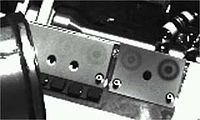- Morten Bo Madsen
-
Morten Bo Madsen 
Born 30 May 1957
Gørding near Esbjerg, DenmarkNationality Danish Fields Geophysics Institutions University of Copenhagen Alma mater Technical University of Denmark Known for Public outreach on Mars research Morten Bo Madsen is a Danish physicist, associate professor at the Niels Bohr Institute.[1] He is known for his engagement in Mars research and his public lectures bringing frontier science to the public.
Madsen was a participating scientist on the Phoenix (spacecraft) Mars mission, where they finally proved the presence of water on Mars.
In 1979 Madsen joined the Mössbauer spectroscopy group at the University of Copenhagen; a group led by Jens Martin Knudsen. During the eighties this research group focused their research on subjects related to studies of the planet Mars and based on ideas by "The Martian", Jens Martin Knudsen formed the Danish Mars Group which soon spurred a sister-group The Mars Simulation Laboratory, in Århus, an initiative by Erik Uggerhøj and Per Nørnberg.
Contents
Pathfinder Mission 1997
Madsen participated in the design and analysis of the five Danish magnetic experiments flown on the 1997 Mars Pathfinder mission.[2]
 One of the Danish magnet experiments carried aboard the Mars Pathfinder Mission
One of the Danish magnet experiments carried aboard the Mars Pathfinder Mission
Where patterns of Martian dust formed on the magnetic plates revealing the magnetic properties of the dust and thus giving hints of the chemical composition of the magnetic component in the dust and geological formation.[3] Madsen's team was one of two the few non US teams who were working close together with NASA on the Pathfinder Mission, the other team was German.[4] The results from the magnetic experiments showed that there had not been liquid water on the surface of mars The last 2 billion years.[5]
Mars Polar Lander 1999
After the success of the Pathfinder mission Madsen's team continued developing the next generation of magnetic experiments for the 1999 Mars Polar Lander mission. Two of the three magnetic experiments were identical to the ones flown on the Pathfinder mission.[5] Unfortunately the Mars Polar Lander lost communication On December 3, 1999.
Mars Exploration Rover Mission 2003
Madsen designed magnetic experiments on board Each of the two rovers, Spirit and Opportunity. Three of the magnets are designed to draw magnetic airborne dust from the atmosphere and four magnets are placed on the arm next to the Rock Abrasion Tool and is designed to catch magnetic dust exposed from the Martian rocks.[6] The dust could then be analyzed by the on board cameras using different filters.[7] The results from the magnet experiment was considered a success in that they helped the understanding of how the dust on Mars was build up.[7] Madsen other members of his team was at the control center at Jet Propulsion Laboratory in Pasadena during the landing and of the rovers and the initial data collection.[5][8] Jens Martin Knudsen stayed in Denmark.
Phoenix 2007
 The color calibration target on Mars showing rings of dust acumilation
The color calibration target on Mars showing rings of dust acumilation
Madsen's team was invited by NASA to design the three Radiometric Calibration Targets for the Phoenix (spacecraft) mission called "Improved Sweep Magnet Experiment" or ISWEEP.[9] The target consisted of a magnesium holder containing a palette of different calibrated colors of synthetic rubber with sweeping magnets underneath to clear the colored material of the magnetic Martian dust. thus they served calibrating the cameras on the mission[10]
References
- ^ staff register, www.nbi.ku.dk, http://www.nbi.ku.dk/english/staff/beskrivelse/?id=168986, retrieved 30 March 2011
- ^ Sinja Sveinsdottir, Thomas A.E. Andersen (06 1997) (in Danish), Lander vi på Mars næste fredag?, Ingeniøren, p. 10
- ^ J. Kjærgaard, Jens (08 1997), Så er der livligt på Mars, Berlingske Tidende, p. 8
- ^ Flarup, Jane (18 August 1997), Den store kærlighed: Mars, Jyllands-Posten, p. 6
- ^ a b c A. E. Andersen, Thomas (4 December 1998), Ny ekspedition til Mars, Ingeniøren, p. 20
- ^ Lauritsen, Sune (02 2004), Mission til Mars, Universitetsavisen, p. 8
- ^ a b Tarp, Davud (4 July 2007), Tiåret for Mars-revolutionen, Berlingske.dk
- ^ Los Angeles: Kjartan styrer på Mars, Stiften.dk, 22 March 2004
- ^ Madsen's great Martian adventure, jp.dk, 15 February 2008
- ^ WESTH, ASGER (13 July 2007), Støvsugermission på Mars, Jyllands-Posten Øs, p. 4
External links
Categories:- 1957 births
- Living people
- Danish physicists
- University of Copenhagen faculty
Wikimedia Foundation. 2010.

